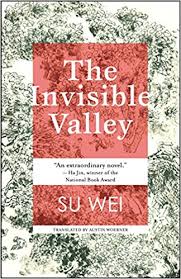 translated by Austin Woerner
translated by Austin Woerner
April 3, 2018
400 pages
Read an excerpt here
Read an interview with the translator here
The Invisible Valley is one of those hard-to-classify novels that resists labels precisely because it’s exploring, through the story it tells, what terms like “fantasy,” “reality,” and “magic” even mean, and how that differs between, and even within, cultures. Here’s the translator, Austin Woerner, discussing how he understands the story:
My sense is that Chinese writers have often employed fantastical elements to grapple with difficult and traumatic things for which traditional realism might seem inadequate….The Invisible Valley isn’t fantasy or magical realism in the traditional sense, though I think it will appeal to readers of both genres. In those genres, magical things really happen; characters slay dragons or storms of yellow butterflies rain down on Macondo. By contrast, The Invisible Valley takes readers into a world where characters believe so strongly in magic that the reader cannot help believe in it too. That’s fundamentally a different kind of storytelling. I see it as having more in common with the work of John Crowley, in which a series of events could have either a magical or a realistic explanation, and it’s up to the reader to decide which to believe.
The merging of the “real” and the “fantastic” that Su Wei describes throughout the novel represents, in part, the dislocation that many young Chinese men and women felt when they were sent to the countryside for “re-education” during the Cultural Revolution. Going from a life spent in cities and in school to one of strenuous field labor and ongoing Party propaganda must have seemed to many like a step into another dimension. The Invisible Valley takes this feeling of dislocation and uses it to explore several different binaries in protagonist Lu Beiping’s life: city vs. country, Party vs. mountain community, tame vs. wild, real vs. fantastic, and others.
The strand that runs through the entire story is “chance”- how it is random and inexplicable and yet has the power to significantly change an individual’s life. In Lu’s case, just picking up a bit of red paper from the ground after coming to Hainan for “re-education” leads him into a “ghost marriage” (a belief among some in Hainan when a dead older sibling is “married” so that the younger sibling may marry without being harassed by the dead). Only after this whirlwind and hasty ceremony, though, does Lu actually learn what it means to be ghost-married, and later, what really happened to his ghost-wife Han. It is this event that sets Lu onto a completely different track from the one he had expected: his ghost-father-in-law, the foreman of his unit, gives him the seemingly-easy job of herding cattle around on the mountainside (manure production is a major part of the unit’s purpose in the region).
Initially terrified by the cacophony of insects, animals, trees, plants, and water, especially at night, which he hears through the thin walls of his small, isolated hut, Lu slowly grows acclimated to his surroundings, experiencing an unsettling yet enriching shift in perspective. He learns about the legends surrounding the spirits that live on the mountain, especially the “Snakeweird” and the myriad ways in which mountain-dwellers keep it at bay:
Deep in the mountains there dwells a giant thousand-year-old python: the Snakeweird, font of the land’s bounty and of its ruin. Never, never, wake the Snakeweird. As Lu Beiping drove his cattle into the foothills, the thought of the Snakeweird was never far from his mind. Never mind if what they said was true; here he was, having recently donned the eerie mantle of ‘ghost husband,’ pressing ever deeper toward the monster’s legendary haunting place. He felt as if he were departing from the land of the living and crossing into the country of shadow…
As Lu travels around the region with his cattle, exploring hidden glens, seemingly-wandering valleys, and dangerous precipices, he gains respect for the folktales and rituals the mountain-dwellers developed over time. Lu soon becomes part of one particular mountain community, falls in love with Jade (the only woman in the group and a powerful force), and embarks upon a complicated friendship with a young “down-countried,” highly-educated man called “Autumn.” All the while, Lu tries to find out exactly what happened to his ghost-wife (was it suicide? murder? malaria?) while trying to figure out if he has indeed crossed over into this mountain life for good, leaving behind the slogans, petty bickering, and competition of the unit.
The question that follows the reader around in this book really comes down to: should we call this “speculative” fiction? If an entire community in the book believes that “reality” includes serpent spirits and wandering valleys, then such stories wouldn’t at all be speculative to them, would they. They seem that way to Lu, at first, but his ultimate immersion in the life and landscape of Mudkettle Mountain unsettles his long-held beliefs about what is real and what isn’t. This gets to the heart of how writers depict “reality,” a discussion that will go on as long as humans write. In The Invisible Valley, Su Wei asks us to broaden our definition of reality, as Lu does, in order to better understand the peoples and landscapes around us.
